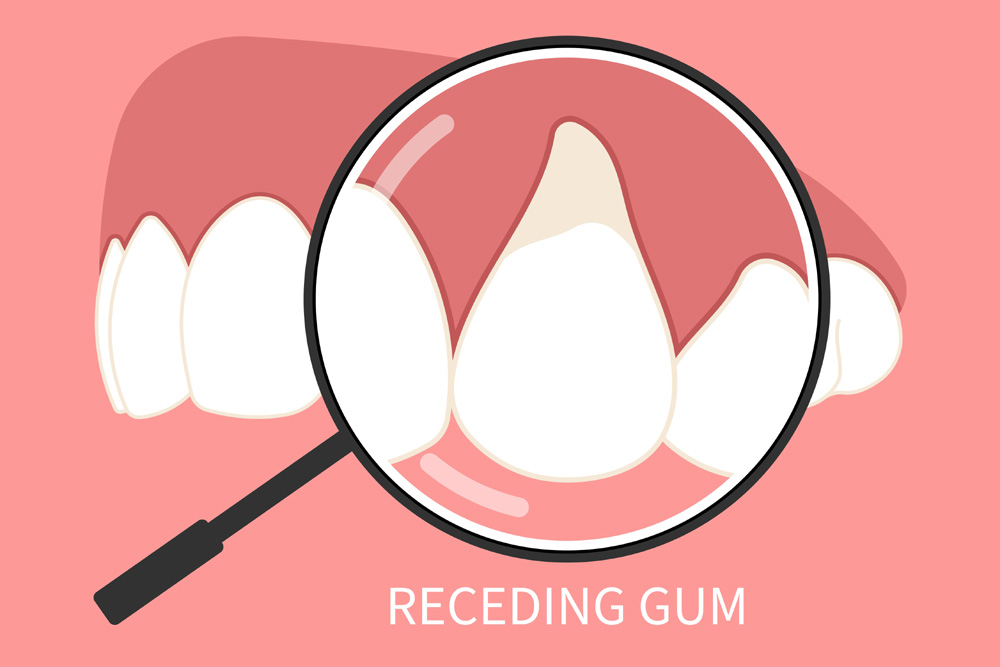
Gum grafting improves oral health and restores a natural smile. Symptoms of gum recession may indicate the need for this treatment. Recognizing the signs early allows for better treatment options and outcomes.
At Dr. Peter Hazim’s practice, we provide expert care for gum recession and related dental concerns. Our experienced team works with patients to develop personalized treatment plans. Identifying symptoms as soon as possible can prevent complications and preserve a healthy smile.
What is Gum Recession?
Gum recession occurs when gum tissue wears away, exposing more of the tooth or root. This condition increases tooth sensitivity and the risk of decay. Bacteria can accumulate in newly formed pockets between the teeth and gums, potentially leading to gum disease. Gum tissue loss affects both oral health and the appearance of a smile, making treatment necessary.
As the condition worsens, teeth lose structural support and become unstable. Without proper treatment, this instability may lead to further complications.
Common Causes of Gum Recession
Several factors contribute to gum recession. Periodontal disease, a bacterial infection, damages gum tissue and bone structure. Aggressive brushing can wear down gums over time. Genetics also influence susceptibility to gum loss. Hormonal changes, tobacco use, and teeth grinding can accelerate the condition, leading to further damage.
Proper oral hygiene and regular dental visits can prevent gum recession. Addressing these factors early reduces the likelihood of requiring gum grafting. Taking control of oral health lowers risks and preserves a strong, healthy gumline.
Signs You May Need Gum Grafting
Recognizing symptoms helps protect dental health. Increased tooth sensitivity often signals gum recession, particularly when exposed roots react to hot or cold temperatures. Receding gums expose more of the tooth, altering the smile’s appearance and making the teeth more vulnerable to decay.
An uneven gumline or persistent discomfort in the gums may indicate the need for a professional evaluation. Ignoring these symptoms may result in further damage, requiring more extensive treatment.
Tooth Sensitivity to Hot and Cold
Tooth sensitivity to hot or cold foods and drinks often suggests receding gums. Exposed roots lack protective enamel, making teeth more vulnerable to external stimuli. Drinking a hot beverage or biting into cold food may trigger sharp pain, signaling gum tissue loss.
Persistent sensitivity requires professional attention. Dr. Peter Hazim evaluates gum health and determines whether gum grafting can restore protection and alleviate discomfort.
Visible Tooth Roots
Receding gums expose tooth roots, increasing sensitivity and decay risk. Due to gum loss, teeth may seem longer, making a smile appear different. Addressing this issue early preserves both oral health and aesthetics.
Exposed roots can cause discomfort during brushing or eating. Consulting a dental professional helps determine the best treatment options. Gum grafting restores coverage and improves both function and appearance.
Redness or Swelling Along the Gumline
Healthy gums are light pink. Redness or swelling may signal infection or inflammation. When left untreated, gum disease often leads to tissue loss and further complications.
Discomfort or tenderness in affected areas can make oral care difficult. Seeking treatment early prevents worsening symptoms. Gum grafting restores gum tissue and enhances overall gum health.
Loose or Shifting Teeth
Loose or shifting teeth indicate insufficient gum support. Gum recession weakens the foundation of teeth, leading to instability. Teeth may feel looser or shift positions, affecting bite alignment and oral function.
Ignoring these symptoms may result in tooth loss. Dr. Peter Hazim assesses gum health and provides solutions to stabilize teeth. Gum grafting strengthens gum tissue and restores stability.
Persistent Bad Breath or Taste
Ongoing bad breath or an unpleasant taste in the mouth may indicate gum disease or infection. Bacteria trapped in gum pockets contribute to these issues. Addressing gum recession reduces the risk of infections and maintains oral hygiene. Treating the underlying cause improves both breath and oral health.
Gum Pain or Discomfort
Pain or discomfort in the gums may signal recession or infection. Healthy gums should not feel sore or tender. Ignoring pain may result in further complications, requiring more extensive treatment.
A professional assessment identifies the cause and provides appropriate treatment options. Gum grafting alleviates discomfort and restores a healthier gumline.
Benefits of Gum Grafting
Gum grafting improves oral health and enhances smile aesthetics. Restoring lost gum tissue protects exposed tooth roots and reduces sensitivity. Strengthening gum support stabilizes teeth and lowers the risk of further recession.
This procedure also prevents future complications. Addressing gum recession early improves long-term oral health and maintains a confident smile.
Seeking Treatment for Gum Recession
Addressing gum recession quickly prevents more extensive dental procedures. Regular dental checkups and proper oral hygiene play an important role in preserving gum health. Receding gums require professional attention to determine the best course of action.
At Dr. Peter Hazim’s practice, our team includes Dr. Nai-wen Chang, our Periodontist who specializes in treating gum recession. We offer services in multiple languages to ensure clear communication for all patients. Gum grafting provides long-lasting benefits, restoring both function and appearance. Contact Peter F. Hazim, DDS at 945-298-0143 or use our contact form to schedule a consultation.

 972-727-5599
972-727-5599